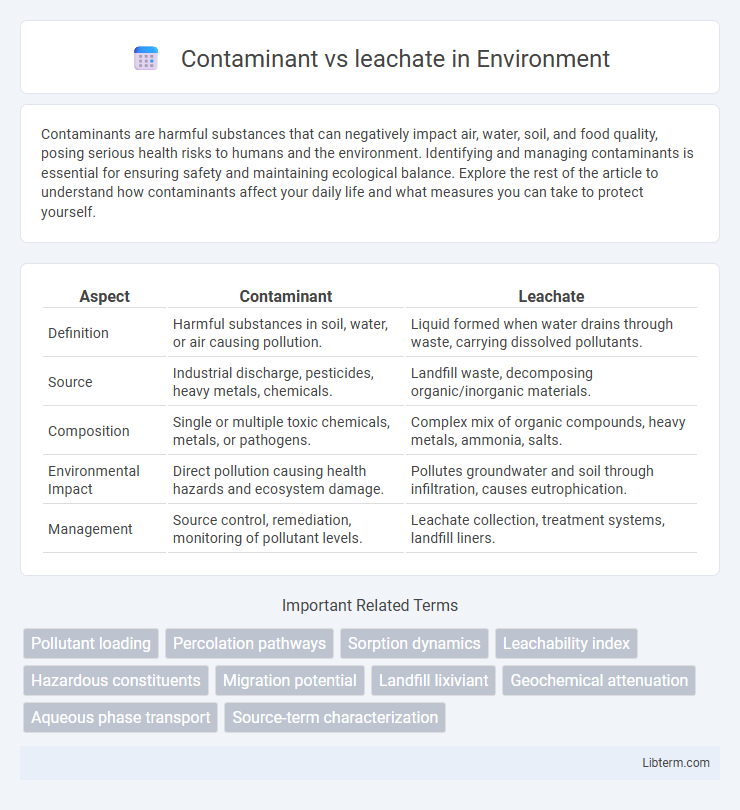Contaminants are harmful substances that can negatively impact air, water, soil, and food quality, posing serious health risks to humans and the environment. Identifying and managing contaminants is essential for ensuring safety and maintaining ecological balance. Explore the rest of the article to understand how contaminants affect your daily life and what measures you can take to protect yourself.
Table of Comparison
| Aspect | Contaminant | Leachate |
|---|---|---|
| Definition | Harmful substances in soil, water, or air causing pollution. | Liquid formed when water drains through waste, carrying dissolved pollutants. |
| Source | Industrial discharge, pesticides, heavy metals, chemicals. | Landfill waste, decomposing organic/inorganic materials. |
| Composition | Single or multiple toxic chemicals, metals, or pathogens. | Complex mix of organic compounds, heavy metals, ammonia, salts. |
| Environmental Impact | Direct pollution causing health hazards and ecosystem damage. | Pollutes groundwater and soil through infiltration, causes eutrophication. |
| Management | Source control, remediation, monitoring of pollutant levels. | Leachate collection, treatment systems, landfill liners. |
Introduction to Contaminants and Leachate
Contaminants are harmful substances that can exist in solid, liquid, or gaseous forms, introduced into the environment through industrial waste, agricultural runoff, and urban activities. Leachate is the liquid that forms when water percolates through waste materials in landfills, dissolving contaminants and carrying them into surrounding soil and groundwater. Understanding the interaction between contaminants and leachate is critical for managing pollution and protecting water quality in landfill sites.
Defining Contaminants: Sources and Types
Contaminants are substances introduced into the environment that cause pollution and can originate from industrial waste, agricultural chemicals, or sewage discharge. These include heavy metals, organic compounds, pesticides, and pathogens, each posing distinct risks to soil, water, and air quality. Understanding the specific sources and types of contaminants is crucial for effective environmental monitoring and remediation strategies.
What is Leachate? Formation and Composition
Leachate is a liquid formed when water percolates through waste materials, extracting soluble substances, suspended solids, and microbial components. It typically originates from landfill sites where rainwater or groundwater interacts with decomposing organic and inorganic waste, resulting in a highly contaminated effluent. The composition of leachate varies widely but commonly includes heavy metals, organic compounds, ammonia, nitrates, and various salts, reflecting the heterogeneous nature of the waste source.
Key Differences Between Contaminants and Leachate
Contaminants are harmful substances present in soil, water, or air that pose risks to human health and the environment, whereas leachate is the liquid that forms when water percolates through waste materials, carrying dissolved or suspended contaminants. Key differences include the fact that contaminants can exist independently in various environmental media, while leachate specifically refers to the contaminant-laden liquid produced from waste decomposition. Understanding the chemical composition and source is crucial, as contaminants encompass a broad range of pollutants, whereas leachate is a complex mixture typically originating from landfills.
Common Sources of Environmental Contaminants
Common sources of environmental contaminants include industrial waste, agricultural runoff, and improperly managed landfills. Leachate forms when water percolates through waste materials, dissolving harmful substances and carrying them into soil and groundwater. Contaminants such as heavy metals, pesticides, and organic chemicals are often present in both leachate and direct environmental pollution.
The Role of Leachate in Pollution
Leachate plays a critical role in pollution as it is a liquid that forms when water percolates through waste materials, extracting soluble and suspended contaminants. This highly contaminated liquid often contains heavy metals, organic compounds, and pathogens that can infiltrate soil and groundwater, posing serious environmental and health risks. Effective management and treatment of leachate are essential to prevent the spread of toxic pollutants from landfills and industrial waste sites.
Health and Environmental Impacts of Contaminants vs Leachate
Contaminants are hazardous substances that pose direct risks to human health by causing respiratory issues, skin irritation, and long-term diseases such as cancer, while leachate, the liquid formed when water percolates through waste, can transport these contaminants into soil and groundwater, leading to widespread environmental pollution. The toxic composition of leachate, often containing heavy metals, organic compounds, and pathogens, results in ecosystem degradation, loss of biodiversity, and contamination of drinking water sources. Persistent exposure to contaminants in leachate elevates health risks through bioaccumulation in the food chain and disruption of aquatic habitats, demanding stringent waste and landfill management practices.
Detection and Monitoring Methods
Detection and monitoring methods for contaminants often involve advanced techniques such as gas chromatography-mass spectrometry (GC-MS) and inductively coupled plasma mass spectrometry (ICP-MS) to identify and quantify specific hazardous substances in soil and water. Leachate monitoring typically relies on sampling from landfill liners and groundwater wells, combined with chemical analyses including total dissolved solids (TDS), heavy metals, and organic compound concentrations to assess the migration of contaminants. Real-time sensors and remote monitoring technologies enhance the ability to track changes in contaminant levels within leachate plumes, providing critical data for environmental risk assessments.
Prevention and Control Strategies
Effective prevention and control strategies for contaminants and leachate focus on source containment and treatment technologies. Implementing engineered liners and leachate collection systems in landfills minimizes contaminant migration into groundwater and surrounding soil. Advanced treatment methods, such as bioreactors and chemical oxidation, enhance leachate quality, reducing environmental impact and ensuring regulatory compliance.
Regulatory Frameworks and Best Practices
Contaminants refer to hazardous substances present in soil, water, or air, while leachate is the liquid that forms when water percolates through waste, often carrying contaminants from landfills. Regulatory frameworks such as the Resource Conservation and Recovery Act (RCRA) in the United States and the EU Landfill Directive establish stringent guidelines for monitoring, managing, and treating leachate to prevent environmental contamination. Best practices include regular leachate collection, treatment systems compliant with National Pollutant Discharge Elimination System (NPDES) permits, and continuous monitoring to ensure contaminant levels remain within regulatory limits.
Contaminant Infographic

 libterm.com
libterm.com